Last updated: January 23, 2025
Article
Samuel Adams: Boston's Radical Revolutionary
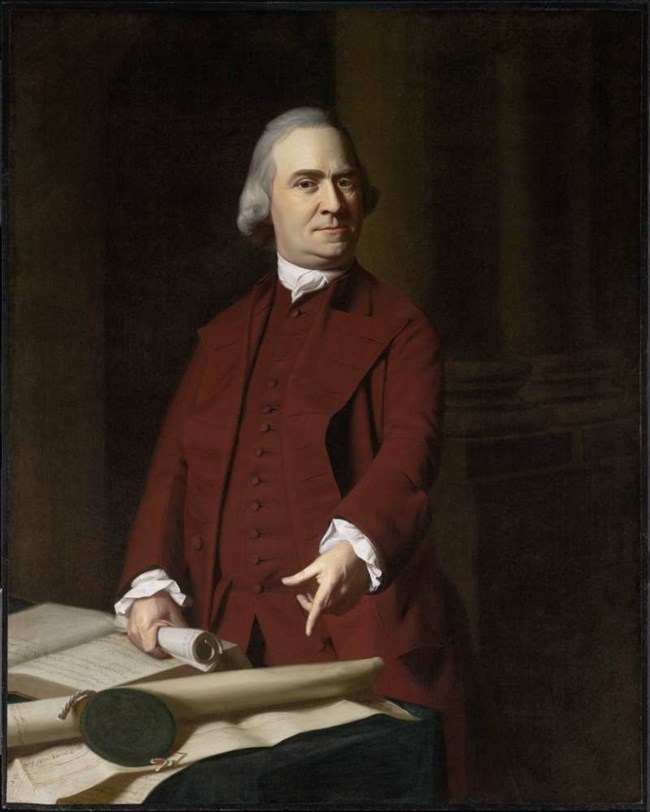
Radical? Virtuous Puritan? Demagogue? Perhaps all of these. When writing of his cousin Samuel Adams, John Adams professed that he had "the most thorough understanding of liberty;" was "zealous and keen in the cause;" and that Samuel embodied "steadfast integrity" and "universal good character."[1] Royal Governor, Thomas Hutchinson had a different perspective of Samuel Adams, claiming there existed no "greater incendiary in the King's dominion or a man of greater malignity of heart who has less scruples any measure however criminal to accomplish his purposes."[2] Whatever one may think of Samuel Adams, it must be conceded that he stood as, above all else, an ardent patriot.
Adams' Beginnings
Samuel Adams was born on September 16, 1722 to Samuel Adams Sr. and Mary (Fifield) Adams in the family home on Purchase Street in the South End of colonial Boston. Both Samuel Sr. and Mary hailed from prominent Boston seafaring families and provided a comfortable and stable home for their children. The elder Adams was a successful malter and active participant in Boston politics. A firm believer in the Massachusetts tradition of self–government, he regularly attended town meeting and served in the colonial legislature. The elder Adams also served as a member of the Boston caucus and a staunch defender of the Massachusetts Charter and Body of Liberties.
Devout Congregationalists of old Puritan stock, the family worshiped regularly at the South Meeting House where Samuel Sr. served as deacon. Samuel Sr. clearly influenced his son both politically and spiritually by instilling in him the Puritan tenet of personal as well as civic virtue. The younger Adams went on to dedicate his life to upholding these ideals.
Young Samuel Adams attended Boston Latin School until entering Harvard College in 1736. During this time, Adams began to formulate his political ideas. The Puritan tradition in New England placed great weight on the concept of covenant, an agreement based on mutual consent and mutual responsibilities. The Massachusetts Charter was considered such a covenant in that it created a government based on the consent of the people. For Adams, liberty and politics worked hand in glove. People could remain free only as long as they had a hand in the government that ruled them.
The writings of Algernon Sydney and political philosopher John Locke also influenced young Adams. Samuel Adams earned his undergraduate degree in 1740 and a graduate degree in 1743. For his thesis he argued, "Whether it be lawful to resist the supreme magistrate, if the commonwealth cannot be otherwise preserved?"
After his years at Harvard, Adams found himself somewhat adrift. In the 1740s he embarked on several unsuccessful career paths. He had considered a career in law but at the urging of his mother he sought employment in the counting house of merchant Thomas Cushing. The merchant life held no interest for Adams and he soon found himself unemployed. Cushing claimed that the young Adams was too preoccupied with politics. Eager to see his son succeed, Adams's father provided his son with a loan to establish his own business. The young man, having little grasp of personal finance and almost no business sense, quickly flittered away the money and began working in his father's Malthouse.
Yet Cushing had correctly identified Adams's passion -- his true interest lay in politics. Adams aligned himself with the "popular party," those citizens who opposed Parliament's infringements of the rights granted them in the Massachusetts Charter. He secured his first political position as a Clerk of the Boston Market in 1747. The following year he helped establish the political newspaper, The Independent Advertiser, and became a frequent contributor. The paper aimed to "defend the rights and liberties of mankind." Unfortunately for Adams, the paper lasted less than a year.
The decade of the 1750s found Adams settling into the responsibilities of family life and beginning to establish his political career. In 1749, Samuel Adams married Elizabeth Checkley: "…she was a rare example of virtue and piety blended with a retiring and modest demeanor and the charms of elegant womanhood." Three years his junior, Elizabeth was the daughter of Samuel Checkley, his pastor at the Old South Meeting House. The couple had six children, only two of which reached maturity, before Elizabeth Adams passed in 1757 due to complications of childbirth.[3] Distraught, Adams immersed himself in politics.
The Young Politician
In 1756, the Boston Town Meeting elected Samuel Adams to the position of tax collector. The position provided him a modest guaranteed income for the first time. By all accounts, however, Adams was unsuccessful at this as well. He often failed to collect the required taxes from many townspeople, being lenient with many in town who could not pay higher rates in an increasingly stagnated economy. The position also provided him the opportunity to mingle with a diverse array of townsfolk and establish connections that served him well in the years to come.
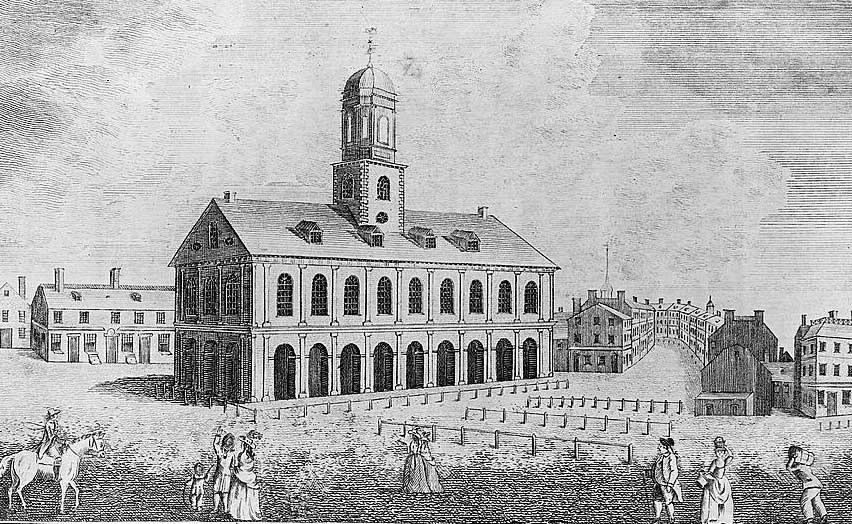
Courtesy the Library of Congress
In 1763 the French and Indian War, as the North American theater of the Seven Years War was known, came to an end with British victory over France. Britain gained control of French Canada but in doing so nearly doubled its national debt. The necessity to raise revenue and to administer the newly acquired territory required Parliament to take greater interest in its colonial possessions.
The Royal Proclamation of 1763 and the Sugar Act of 1764 served as the first salvos in Parliament's attempt to gain greater control over the colonies. The Sugar Act was a trade regulation intended to raise revenue while curtailing smuggling. The Act, a tax on molasses imported into the colonies from the West Indies, disproportionately affected Massachusetts and the other New England colonies that depended on the molasses for their rum distilling industries. The protests surrounding the Act found Adams beginning to emerge as a prominent voice in local politics. A member of the Town Meeting and a vocal critic of the tax, Adams voiced the Meeting’s opposition to the Act in that body’s instructions to Boston’s representatives in the colony’s legislature. It provided him the leadership opportunity he seemed destined for. He suggested that the thirteen colonies present united opposition and echoing James Otis’ thoughts about taxation without representation, wrote:
For if our Trade may be taxed, why not our Lands? Why not the Produce of our Lands & everything we possess or make use of? This we apprehend annihilates our Charter Right to govern & tax ourselves. It strikes at our British privileges, which as we have never forfeited them, we hold in common with our Fellow Subjects who are Natives of Britain. If Taxes are laid upon us in any shape without our having a legal Representation where they are laid, are we not reduced from the Character of free Subjects to the miserable State of tributary Slaves?[4]
By questioning Parliament's authority over the colonies and suggesting united opposition, Adams highlighted the duality of Puritan New England’s fundamental conservatism and unhesitating radicalism while laying a cornerstone for a revolution. The Town Meeting, a form of government created by Adams' forebears and unique to New England, now challenged the authority of an empire's legislature.
Samuel Adams wed his second wife in 1764. Elizabeth Wells was the daughter of his good friend Francis Wells, a successful Boston merchant. The couple had no children together but 'Betsy' embraced her step children as her own and supported her husband throughout his political career. A true adherent of John Winthrop's dictum, "The care of the public must oversway all private respects," Adams's unwavering determination to preserve the rights of his fellow countrymen frequently put his estate, reputation, and life at risk.[5] That single minded pursuit took him away from home for the greater part of the 1770s, effectively making Betsy a single mother. Her strength and fortitude nurtured the family and helped preserve their meager finances.
In March 1765, Parliament passed the Stamp Act requiring that most printed materials bear a revenue stamp. The Act also made provision for violators to be tried in Admiralty Court rather than locally by a jury of their peers. This sparked outrage throughout the colonies and riots in Boston. Unlike the previous year’s Sugar Act, this tax affected nearly all colonists as well as denied colonial rights. For Adams, this violated the covenant he held so dear. Adams's leadership during The Stamp Act Crisis of 1765 and his close association with the Loyal Nine (a precursor to the Sons of Liberty) solidified his influence in the growing movement against Parliamentary taxation and legislation. Once again, those meeting in Faneuil Hall tasked him with drafting the town’s instructions to its representatives in the House. Joining his cousin John Adams, whose Braintree Instructions outright rejected Parliament’s authority in the colonies, Samuel wrote:
We therefore the Freeholders and other inhabitants, being legally assembled in Faneuil Hall to consider what steps are necessary for us to take at this alarming Crisis… It follows, that at once it [the Stamp Act] annihilates the most valuable privileges of our Charter, deprives us of the most essential rights of Britons, and greatly weakens the best security of our Lives, Liberties and Estates.
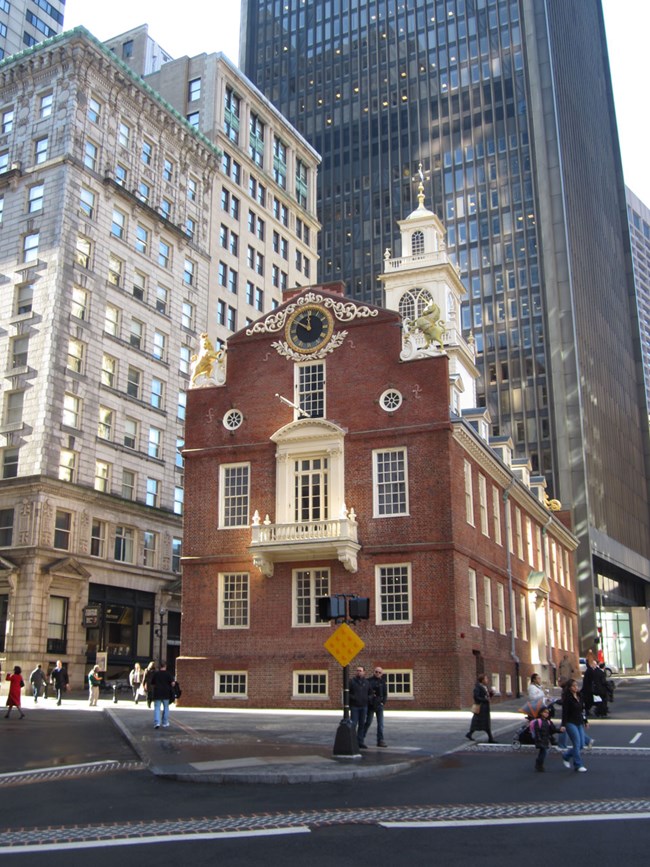
An Emerging Political Leader
In September of that year Adams became elected to the Massachusetts General Court, or Massachusetts House of Representatives, (a seat he held for the next 9 years) and began dividing his time between Faneuil Hall and the Town House (today’s Old State House). Almost immediately he began penning a series of resolutions defending the rights and liberties of the people of Massachusetts:
…that all acts made by any power whatever, other than the General Assembly of this Province, imposing taxes on the inhabitants, are infringements of our inherent and inalienable rights as men and British subjects, and render void the most valuable declarations of our charter.
Parliament voted to repeal the Stamp Act in 1766, giving colonists a monumental victory. The repeal in Parliament, however, was contingent on the passage of the Declaratory Act. This act stated that Parliament "had hath, and or right ought to have, full power and authority to make laws and statutes of sufficient force and validity to bind the colonies and people of America…in all cases whatsoever." The actions against the Stamp Act and the resulting repeal found the opposition party gaining power in the Massachusetts Legislature. Adams was selected as Clerk of the House and fellow Bostonian Thomas Cushing was chosen as Speaker. Prosperous Boston merchant John Hancock also took a seat in that year’s elections, joining Adams, Cushing, and James Otis.
As Clerk, Adams became responsible for basic record-keeping and communication with the colony’s agent in London as well as with other legislative assemblies in the colonies. He used this position adeptly to help advance the radical agenda of his party and protect Massachusetts' Chartered rights. Most representatives in the Massachusetts Legislature did not receive a salary. The position of Clerk, however, was on of the few which paid a salary. For the first time, Adams now had a steady income in his career and could focus even more attention to politics.
Eager to reassert its authority, in 1767 Parliament approved a series of taxes on particular items imported into the colonies. Known as the Townshend Acts, the act also created an American Board of Customs Commissioners to enforce collection and established their headquarters in Boston. When news of the Acts reached Massachusetts in the autumn of 1767, Adams employed the Boston Town Meeting to organize protests and boycotts. In January of the New Year he motioned the General Court to draft a petition to the King urging he and Parliament respect of the Charter rights of Massachusetts. The motion faced opposition from representatives from some of the more rural towns in the province that still aligned with Parliament. A crafty politician, Adams waited until the end of the legislative session when many of those in opposition had departed and put forth the motion again. It passed easily.
The General Court then decided to send the petition to the other colonies along with a letter urging united resistance to the new taxes. Known as the Massachusetts Circular Letter, Adams (one of the primary authors) argued that only colonial legislatures had the right to tax. When Lord Hillsborough, Secretary of State for the Colonies, received the letter he ordered that the letter be rescinded. If the House refused, Hillsborough ordered Massachusetts Governor Francis Bernard to dissolve the General Court. When it came to a vote, the Legislature overwhelmingly refused to rescind the letter: 92 to 17. Governor Bernard dissolved the Legislatur, which did not reconvene for almost another year.
While the inside of the Old State House rocked with political defiance, outside the Old State House Adams and his fellow radicals urged Boston merchants not to import luxury goods from Britain. They encouraged the people of Massachusetts to become more self-sufficient. A grassroots program of intimidation against the Customs Commissioners and their staff also began at this time and although there is no evidence that Adams supported this, he certainly did not discourage it. In response to growing civil disobedience and threats of violence against them, the Commissioners requested that a force of the King’s Army be dispatched to Boston to serve as peacekeepers. Rumors circulated in the late Summer that an army would soon occupy Boston.
British citizens in the 1700s widely believed that a standing army posed a threat to the liberties of the people. Outraged by the seemingly imminent arrival of troops in Boston, Adams called for a special town meeting to be convened in Faneuil Hall. Careful not to provoke outright civil war, the meeting was held under the pretext of discussing how to defend the town against a possible French attack. The meeting voted to ask the Governor to call the Massachusetts Legislature back into session and address the current events. The Governor refused and Adams responded by calling for a convention of all Massachusetts towns to meet in Faneuil Hall. Sixty seven towns sent representatives. For all intents and purposes, this served as a meeting of the Legislature without the Royal Governor’s approval. A foreshadowing of the creation of the Provincial Congress created in 1774? The convention passed several resolutions in protest but nothing material resulted from the meeting.
Fanning the Flames of Resistance
Troops finally arrived in Boston on October 1, 1768. Adams once again took up his quill and under the pseudonym "Vindex" he wrote:
Will the spirits of the people as yet unsubdued by tyranny, unawed by the menace of arbitrary power, submit to be governed by military force? No. [6]
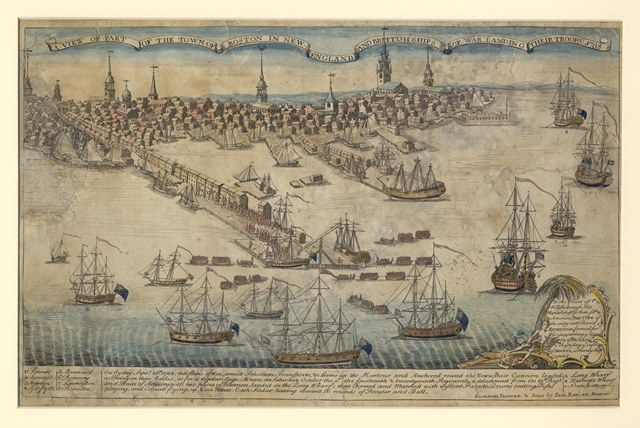
Courtesy American Antiquarian Society
One thousand of His Majesty's soldiers patrolling Boston's streets forced the radicals to be more discreet in their protests. Adams kept busy employing his rhetorical and literary skills, creating Committees of Correspondence, writing circular letters, essays, articles for newspapers and well as honing his talent as a master of propaganda. Historian Samuel Eliot Morrison observed:
He was no orator – he had a quavering voice and a shaky hand; so he let other Sons of Liberty like Joseph Warren and the firebrand James Otis makes the speeches while he wrote provocative articles and pulled political strings.[7]
Between 1768 and 1769, Adams authored over twenty newspaper articles under the pen names "Vindex" and "Candidus." In these articles he railed against the Commissioners of Customs and the standing British Army. More directly, Adams raised the stakes of the boycott and advocated that Boston merchants refuse to import all British goods – a Non-Importation agreement among Boston’s merchants for one year's time. He employed the old Puritan idea of a covenant to encourage the common purpose among Boston's merchants as well as those of other colonies and to remind the people that self-denial was a virtue:
One spirit, animates all America…to quench the spirit all the colonies must be absolutely destroyed.[8]
Unfortunately for Adams, profit often trumped patriotism. Many of Boston's merchants expressed their support of non-importation in public while privately looking at their bottom line. Many merchants covertly imported goods to be stored in warehouses until non-importation ceased. Committees of Inspection were established to investigate those who were subverting the pact. While at first those in violation were publicly humiliated and sometimes physically abused until they repented, the agreement became difficult to enfore. Eventually those who disagreed with Adams found a platform in The Boston Chronicle, a newspaper published by John Mein that sought to unmask the duplicitous merchants and weaken the non-importation movement.
Although Adams desperately tried to maintain non-importation, the beginning of 1770 saw the scheme falling apart. At the end of the year-long agreement merchants eagerly resumed business. In the press, Adams began shaming those who would not extend the agreement:
Have you not a right if you please, to set fire to your own houses, because they are your own, though in all probability it will destroy a whole neighborhood, perhaps a whole city![9]
Adams may have been discouraged by the lack of enthusiasm for non-importation among the merchants, but he could take heart that many average citizens in Boston rallied to his call. The essence of John Winthrop's Model of Christian Charity was etched in their very being: "We must knit together in this work as one man, we must entertain each other in brotherly affection, we must be willing to abridge ourselves of our superfluities for the supply of others' necessities." Importers often found themselves the targets of mob intimidation and violence. The presence of troops in the town also added to the animosity, an animosity that Adams helped to fuel. Between 1768 and 1769, he had written at least thirteen newspaper articles addressing the presence of a standing army in Boston.

Courtesy Library of Congress
Meetings, Mobs, Martrys
As 1770 approached that tension began to flare in minor confrontations between the citizens and the soldiers. In November 1769, Adams wrote:
It is with astonishment and indignation that the Americans contemplate the folly of the British Ministry in employing troops…to parade the streets of Boston. One winter more trifled away, or worse than trifled in fruitless endeavors to enslave a people…We tremble for her fate [England] – we wish her prosperity – we hope she will soon employ herself to nobler purposes…Britain may fall sooner than she is aware; while her colonies who are struggling for liberty may survive her fate and tell the story to their children’s children.[10]
Tensions erupted on February 22, 1770 when, harassed by a mob and fearing for his safety, a minor customs official named Ebenezer Richardson accidentally shot and killed 11 year old Christopher Seider.
While likely a tragic accident, Adams seized the opportunity to call out the injustice. He organized a funeral attended by over two thousand people. The procession passed Faneuil Hall, the Town House (Old State House), and the Liberty Tree before ending at the Granary Burial Ground. Seider became a martyr, uniting the people of Boston against unwarranted British authority.
The death of Seider only increased the agitation felt by both the townsfolk and the soldiers. By early March 1770, having lived under an occupying army for 17 months as well as two years of Townshend duties and non-importation, the people of Boston began to express their frustration and anger. Unable to act without direction from the Governor, the soldiers felt impotent. They were tired of the constant insults and jeers. It seemed only a matter of time before open hostilities broke out.
The mounting stress burst on March 5, 1770 when nine of His Majesty's soldiers found themselves facing off a mob of several hundred angry citizens. Acting in self-defense though without orders the soldiers fired into the crowd. Five civilians were killed and six wounded. This unfortunate incident occurred on King Street just outside the Town House and became forever known as the Boston Massacre.
A constant critic of the occupation, Adams immediately recognized the propaganda value of the event. On March 6, he led a committee to the Town House to demand the removal of the troops from the town. Informed by the Acting Governor, Thomas Hutchinson, that such an order fell to the military command in town, the committee crossed the street to Faneuil Hall where an emergency town meeting was in session. Adams addressed those assembled, obtained a unanimous vote demanding the removal of the troops before there was further bloodshed and was appointed to lead a committee of fifteen to present the demand to the Governor. It was suggested that if the demands were not met surrounding towns might send armed men to Boston in an attempt to force the soldiers out. Faced with such a crisis, Hutchinson and his Council bowed to the demand and Hutchinson wrote to the military commander:
I am sensible I have no power to order the Troops to the Castle, but under the present circumstances of the Town and the Provence I cannot avoid in consequence of this unanimous advice of the council desiring you to order them there which I must submit to you.[11]
Lt. Colonel Dalrymple agreed and ordered the troops to Castle Island (Castle William) in the harbor. Samuel Adams and the opposition scored a great victory. The soldiers involved in the shooting were arrested and awaited trial.
Adams had hoped for a quick trial but the date was set for the autumn, allowing passions to cool. He cared not if the soldiers were judged guilty or innocent. His only concern was that Town of Boston be seen as the victim. Nonetheless, having studied law himself he knew that a fair trial was essential. Arguments that Britain did not respect the liberties of the colonies would lose authority if the colonists could not uphold due process in return. Skilled defense attorneys would be key to achieving this goal. Few attorneys were willing to risk their careers defending the soldiers but there were two that Adams knew he could count on: Josiah Quincy and his own cousin John Adams. Quincy wrote that he accepted the position only after he had been "…advised and urged to undertake it by an Adams, a Hancock, a Molineux, a Cushing, a Henshaw, a Pemberton, a Warren, a Cooper and a Phillips." Although there is no firm evidence, John Adams may have had a similar visit.
While John Adams and Josiah Quincy argued that the soldiers fired in self-defense, they also made grander statements that the soldiers should not have been in Boston and put in such a situation to begin with. At the conclusion of the trial, only two privates were found guilty of manslaughter. It proved that Massachusetts could administer justice fairly while at the same time glossing over evidence that may have been harmful to the town.
Keeping the Cause Alive
In April 1770, news of the repeal of all but one of the Townshend taxes reached American shores. The one remaining tax (that on tea) allowed Parliament to maintain its prerogative to tax the colonies. The repeal coupled with the removal of the troops and the successful conclusion of the trial ushered in a period of calm that lasted throughout 1771 and 1772. Samuel Adams, however, did not rest.
In the Massachusetts House of Representatives, Boston Town Meeting, and the press, Adams fought to keep the opposition alive. Although privately happy with the outcome of the trial, publicly he continued to rail against it. Between December of 1770 and January 1771, again writing under the name "Vindex," he produced a series of articles condemning the court’s decision. He pushed for the colonies' rights to self-government. Understanding that no colony could succeed on its own, he sought to create some form of colonial association. While corresponding with Arthur Lee of Virginia, Adams suggested that societies be formed throughout the colonies to correspond with one another and present a united opposition to Parliament, "And if conducted with a proper spirit, would it not afford reason for the enemies of our common liberty, however great, to tremble?"[12]
In the late spring 1771, Boston received news that the Governor's salary would no longer be voted upon by the legislature. Instead, it would be paid entirely by the Crown with revenue from the tax on tea. Rather than embracing this news as a financial burden lifted from the colony, Adams argued in the press that Parliament's use of colonial tax revenue for the administration of the colony would threaten the balance of power and set precedent allowing the support of standing armies, ministerial pensioners, and the Anglican Church. Writing as "Cotton Mather" in the Boston Gazette, Adams called upon his beloved Charter rights:
Did not our ancestors, when they accepted this Charter, understand that they had contracted for a free government? Was it not understood that by this contract every power of government was to be under a check adequate to the importance of it … without which that power would be tyranny?[13]
Adams found it difficult to maintain the momentum of rallying a populace weary of the fight, yet after nearly nine years of protest Adams was far from giving up. For him, Boston remained the 'City upon a Hill,' an example for the rest of the world. The autumn of 1772 brought news that reawakened Boston and the entire colony of Massachusetts. Judges of the Superior Court, like the Governor, would no longer be paid by the legislature but from the Crown. Adams became re-energized, and his fury brought the people back into line with the Covenant:
To what a state of infamy, wretchedness, and misery shall we be reduced if our judges shall be prevailed upon to be thus degraded to hirelings, and the Body of the People shall suffer their free Constitution to be overturned and ruined? Let not the iron hand of tyranny ravish our laws and seize the badge of freedom…and the murderous rage of lawless power be ever seen on the sacred seat of justice![14]
Bostonians called a special town meeting at Faneuil Hall on October 28 to discuss the matter. Here, they passed a resolution creating a committee to meet with the governor and express the concerns of the town. Adams was selected head of the committee. Governor Hutchinson listened to their concerns but refused to share any relevant information with them. The Town Meeting then petitioned for the legislature to convene. The governor again refused, citing that it was not in the town’s authority to address issues beyond those of local government. During a meeting at Faneuil Hall on November 2, Adams offered a resolution calling for the establishment of Committees of Correspondence throughout Massachusetts and the creation of a Declaration of Rights of the Colonists. Similar committees began to spring up throughout the colonies, and Massachusetts soon shared its 'declaration.'
Tea and Tyranny
After nearly a decade of riots, boycotts and protests, the final blow in the crisis with Parliament struck on May 10, 1773. Parliament passed the Tea Act. Designed to rescue the financially failing East India Tea Company, the Act granted the company a monopoly on sales in the colonies by appointing designated consignees. This allowed it to rid itself of a ruinous surplus of tea while also enabling the government to reinforce Parliament's right to tax the colonies. News of the Tea Act sparked protest throughout the colonies. Outrage and threats against the consignees forced many to resign and tea ships to turn away. While this campaign of protest and intimidation succeeded in most colonies, Massachusetts was a different story.
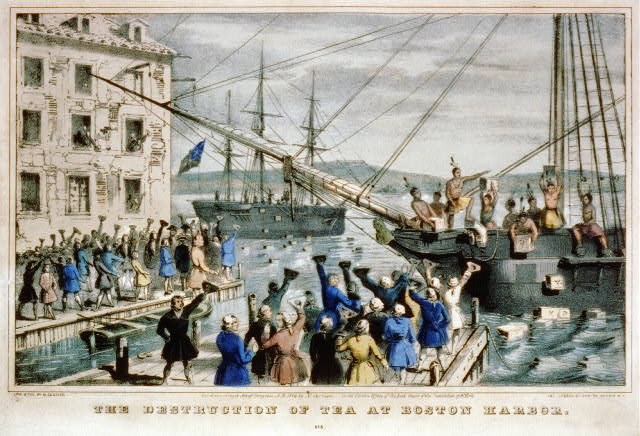
Courtesy Library of Congress
The tea consignees in Boston refused to be intimidated. On October 18, three tea ships sailed for Boston. The first to arrive was the Dartmouth on November 28. By law, the duty on the tea had to be paid within 20 days or the cargo would be seized by customs and put up for auction. Adams and his fellow radicals knew that if the tea landed either voluntarily or by seizure it would eventually be sold and thus taxed. Their aim was to prevent it from being unloaded entirely.
The Boston Committee of Correspondents posted a guard at Griffin's Wharf where the Dartmouth anchored. An emergency town meeting was called on October 28 at Faneuil Hall, but the Hall soon filled beyond its capacity and the meeting was adjourned to the Old South Meeting House. A unanimous resolution called for the tea to be sent back to England, stating that "…a virtuous and steady opposition to the Ministerial Plan of governing America is absolutely necessary to preserve even the shadow of Liberty…”[15]
Customs officials refused. Using Adams's Committee of Correspondence, Boston sought and received support for its resolution from many towns throughout Massachusetts. The Beaver and the Eleanor soon joined the Dartmouth. Guards were placed on the wharf to guard the three ships.
The 20 day deadline on the Dartmouth was December 17. After several meetings at Old South and several unsuccessful attempts at turning back the ships, Adams chaired a final meeting on December 16. This time attendees appealed directly to Governor Thomas Hutchinson. Hutchinson replied from his country home outside Boston that he would not be swayed by the “mob” and insisted the cargo would be unloaded the next day. Expecting such a response, Boston’s Sons of Liberty took matters into their own hands. Men with faces covered in soot and charcoal made their way to the three ships bearing the tea. After hours of teamwork, the members destroyed 342 chests of tea. There is no evidence that Adams took part in the destruction of the tea, but he wasted no time in praising it:
You cannot imagine the height of joy that sparkles in the eyes and animates the countenances as well as the hearts of all we meet on this occasion.[16]
When news of the destroyed tea reached England in early 1774, Parliament reacted swiftly and harshly with a series of bills known as the Coercive Acts. The first bill, the Boston Port Bill, closed the port of Boston to incoming as well as outgoing trade until Massachusetts made reparations for the destroyed tea. The Bill also transferred the seat of colonial government from Boston to Salem, some 25 miles north. The Massachusetts Government Act soon followed. The Government Act stripped Massachusetts of its Charter and limited town meetings to one per year unless otherwise directed by the Governor. The Administration of Justice Act and the Quartering Act rounded out the series. The Acts only united the people of Massachusetts. Through the Committees of Correspondence network, Boston sought and soon received aid not only from Massachusetts towns but also from communities throughout the colonies. On June 17, 1774 Adams drafted the Resolves of the Massachusetts House of Representatives, asking for both aid and advice:
Whereas the towns of Boston and Charlestown are suffering under the Hand of Power, by shutting up the harbor by an armed force, which is in the opinion of this House an invasion of the said towns evidently designed to compel the inhabitants thereof into a submission to taxes imposed on them without their consent and whereas it appears to this House that this attack upon the said towns for the purpose of the aforesaid is an attack made upon this whole Provence and continent which threatens the total destruction of the liberties of all British America.[17]
On the Path to War and Independence
To enforce these laws and bring Massachusetts under control, General Thomas Gage was appointed military Governor of the province and 4,000 troops were sent to garrison the town. Samuel Adams reacted quickly. In June, he chaired a committee in the House of Representatives, now meeting in Salem, which proposed electing individuals to represent Massachusetts at a colonial congress scheduled to meet in Philadelphia to discuss the crisis in Boston. Needless to say, he was selected to be one of the delegates.
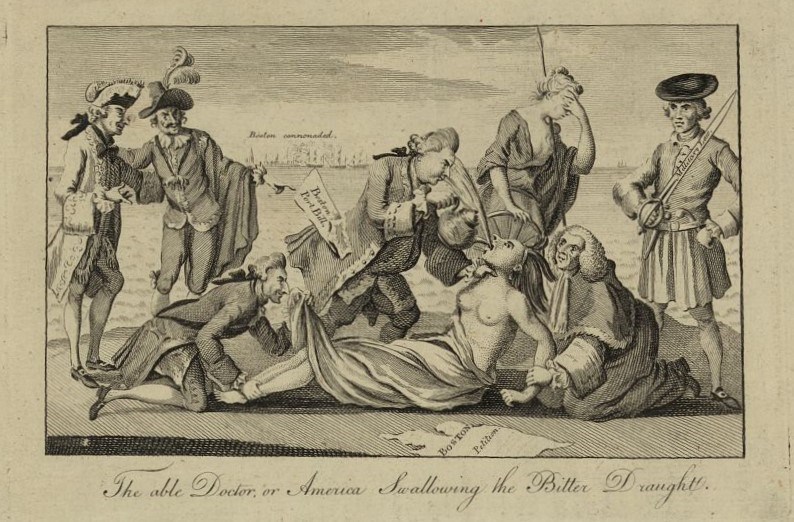
Courtesy Library of Congress
As the First Continental Congress convened in September, the situation in Massachusetts only grew more desperate. In Adams's absence, his good friend Joseph Warren assumed the leadership role of the opposition. Warren soon penned The Suffolk Resolves, a virtual declaration of independence for Massachusetts. Working together closely through correspondence, Adams and Warren put forth a bold suggestion - the creation of an opposition government! Adams knew that for such a plan to be successful the people of Massachusetts must be united, writing to Warren:
That union is most likely to be obtained by a consultation of deputies from several towns either in a House of Representatives or a Provincial Congress…the people would be united in what they would easily see to be a constitutional opposition to tyranny. You know, there is charm in the word 'constitutional.'[18]
On September 25, 1774 Adams wrote to Warren informing him that the Congress had given its assent to his Suffolk Resolves, and:
They strongly recommend your perseverance in a firm and temperate conduct, and give you a full pledge of their united efforts on your behalf. I have been assured in private conversation with individuals, that, if you should be driven to the necessity of acting in defense of your lives or liberty, you would be justified by their constituents and openly supported by all means in their power.[19]
The Massachusetts Provincial Congress first met in October 1774 and assumed all legislative, financial, and military powers for the colony beyond Boston. The die had been cast and the possibility of civil war loomed. The Congress promptly took a defensive stance against possible military aggression by His Majesty’s Troops by seizing several pieces of military ordinance, stockpiling supplies, and creating "Minute man" companies of militia. Observing the situation, a young Quaker from Rhode Island, Nathanael Green wrote, "Soon very soon expect to hear the thirsty earth drinking in the blood of American sons."[20]
The Continental Congress in Philadelphia adjourned in November with a mandate to reconvene in May of 1775 should matters fail to improve. Samuel Adams returned to Massachusetts to take his seat in the Provincial Congress. There he worked tirelessly for the next five months to obtain and distribute aid to the people of Boston still suffering under the closure of the port.
Meanwhile, General Gage was under increased pressure from the Ministry in England to put an end to the rebellion in Massachusetts. Gage wished to avoid conflict as much as possible and did not initially attempt to arrest opposition leaders like Samuel Adams for fear that such a move might spark a violent backlash. Instead, Gage sought to prevent the Provincial Congress from acquiring any further military supplies. This led to a number of relatively harmless encounters between His Majesty's Troops and local militias known as Powder Alarms. Each side attempted to capture local gunpowder stores and military ordnance before the other. On April 14, 1775 Gage received letters from the Secretary of State which forced his hand. He was ordered to disarm the militias and arrest the leaders of rebellion immediately.
Founding Father
The arrival of spring brought no improvement to the state of affairs in Massachusetts. A second Continental Congress was deemed necessary. Samuel Adams was once again selected, along with John Adams, John Hancock, and Robert Treat Paine, as a delegate to the Congress. Before departing for Philadelphia in early April, Samuel Adams and John Hancock attended a session of the Provincial Congress then meeting in the town of Concord, 15 miles northwest of Boston. Aware of Gage’s recent orders, the men elected to stay at the home of the Reverend Clarke in the neighboring town of Lexington rather than risk arrest in Boston.
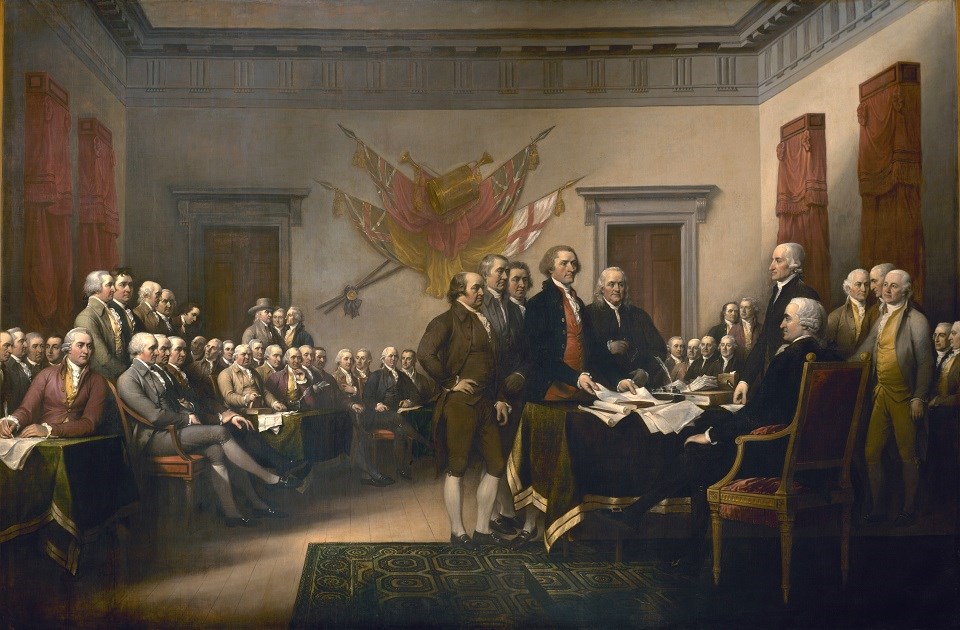
Courtesy Architect of the Capitol
Meanwhile, bowing to the increasing pressure to act, Gage ordered a column of troops to Concord to seize and destroy a suspected cache of munitions. Ironically, the march took them directly through Lexington. There is no evidence to suggest that Gage had ordered the arrest of Adams and Hancock that day, but fearing the possible capture of the two men, Joseph Warren dispatched riders Paul Revere and William Dawes to warn the delegates to move on. The troops arrived in the Lexington on the morning of the April 19 just as Hancock and Adams escaped. Skirmishes between His Majesty's Troops and armed militia on that day at Lexington Green and Concord’s North Bridge marked the beginning of the armed insurrection that eventually became America's War for Independence.
Events began to progress quickly in the spring and early summer of 1775. In rapid succession, the Continental Congress established an Army, was notified of the Battle at Bunker Hill, and ordered an invasion of Canada. Throughout the years of struggle leading to the Second Continental Congress, Adams came to the realization that allegiance to the Crown and possible reconciliation with Parliament was impossible. Independence seemed the only logical course. The outbreak of hostilities solidified his conviction and he worked deliberately and patiently to convince his fellow delegates that a complete break with Great Britain was necessary. As the calendar turned from 1775 to 1776, war began to spread throughout the colonies. Adams gained more support for the cause of independence:
Is not America already independent? Why then not declare it? Can nations at war be said to be dependent either upon the other?[21]
The ideas of independence spread far and wide among the colonies. Many of the leading men see the absurdity of supposing that allegiance is due to a sovereign who has already thrown us out of his protection.[22]
The idea conceived of 130 years earlier by John Winthrop in an address to the Massachusetts General Court, an idea ingrained in Adams's soul, was finally coming to fruition not just for Massachusetts, but for all of Britain’s North American Colonies:
There is a two-fold liberty, natural (I mean as our nature is now corrupt) and civil or federal. The first is common to man with beasts and other creatures…The other kind of liberty I call civil or federal; it may also be called moral, in reference to the covenant between God and man, in the moral law, and the politic covenants and constitutions between men themselves. This liberty is the proper end and object of authority and cannot subsist without it: and it is a liberty to that only which is good, just and honest. This liberty you are to stand for, with the hazard (not only of your goods, but) of your lives if need be.[23]
On June 7, 1776, Richard Henry Lee of Virginia proposed a resolution to Congress calling for independence from Great Britain. Following several weeks of debate, Congress adopted the resolution on July 2, 1776. On July 4, after years of determined effort arguing for the rights of Americans in defiance of Parliament, Adams cast his vote to ratify the Declaration of Independence.
Thirty-three years after posing the argument "Whether it be lawful to resist the supreme magistrate, if the commonwealth cannot be otherwise preserved?" in his Master's Thesis, Adams finally arrived at a conclusion.
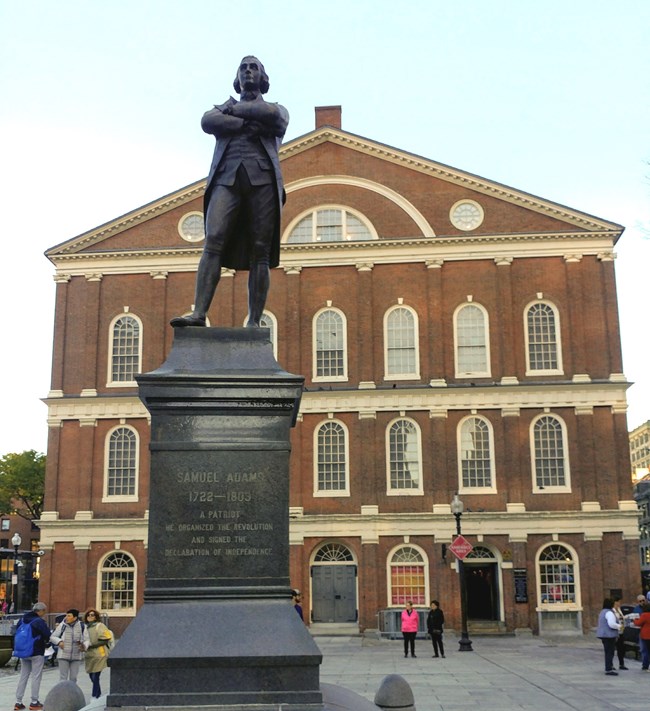
Lasting Legacy
In 1779, Samuel Adams, John Adams, and James Bowdoin were selected to draft a constitution for the State of Massachusetts. Among the many sources drawn upon in the creation of the document were the Massachusetts Charter and the Massachusetts Body of Liberties. The people of Massachusetts ratified the Constitution of the Commonwealth of Massachusetts in their town meetings in 1780.
Throughout this time Adams continued to serve as delegate to the Continental Congress. The Congress worked secretly behind closed doors, however, and there are few details about the role that Adams may have played after the Declaration of Independence was signed. He did serve on several Congressional committees, held a position on the Board of War, and helped draft the Articles of Confederation before returning home to Massachusetts in 1781. The remainder of Adams' career was devoted mainly to state rather than national politics. In the 1780s, Adams served as President of the Massachusetts Senate, and from 1789 to 1793 he served as Lieutenant Governor under Governor John Hancock. When Hancock died in office, Adams assumed the governorship. Following that term, Adams was elected in his own right to three successive one-year terms as Governor of the Commonwealth of Massachusetts. He retired from politics after his tenure as Governor in 1797. Samuel Adams died at the age of 81 on October 2, 1803 and was interred at the Granary Burying Ground.
In 1819, Thomas Jefferson wrote of Samuel Adams:
I can say that he was truly a great man, wise in council, fertile in resources, immovable in his purposes…although not of fluent elocution, (he) was so rigorously logical, so clear in his views, abundant in good sense, and master always of his subject, that he commanded the most profound attention whenever he rose in an assembly…[24]
Footnotes:
[1] John Adams, Diary of John Adams, December 23,1765.
[2] William V. Wells, The Life and Public Services of Samuel Adams (Boston: Little Brown and Co., 1865) 410.
[3] Harry Clinton Green and Mary Wolcott Green, Wives of the Signers: the Women Behind the Declaration of Independence (Wallbuilder Press, 1997).
[4] Samuel Adams, To the Representatives of Boston, May 24, 1764. The Writings of Samuel Adams Vol I 1764-1769, collected and edited by Harry Alonzo Cushing (G.P. Putnum, 1904) 5.
[5] John Winthrop, John A Model of Christian Charity, 1630.
[6] Boston Gazette, December 5, 1768.
[7] Samuel Eliot Morison, Oxford History of the American People (New York: Oxford University Press, 1965) 192.
[8] Boston Evening Post, April 10, 1769.
[9] Boston Gazette, January 8, 1770.
[10] Samuel Adams to Dennys De Berdt, November 16,1769.
[11] Thomas Hutchinson to William Dalrymple, March 6, 1770.
[12] Samuel Adams to Arthur Lee, September 27,1771.
[13] Boston Gazette, November 25, 1771.
[14] Boston Gazette, October 5, 1772.
[15] Resolutions of the Town of Boston, November 5,1773.
[16] Samuel Adams to Arthur Lee, December 31, 1773.
[17] Resolutions of the House of Representatives of Massachusetts, June 17, 1774.
[18] Samuel Adams to Joseph Warren, September 24, 1774.
[19] Samuel Adams to Joseph Warren, September 25, 1774.
[20] Nathanael Green to Samuel Ward Jr., July 10, 1774.
[21] Samuel Adams to Samuel Cooper, April 3,1776.
[22] Samuel Adams to Joseph Hawley, April 15,1776.
[23] John Winthrop, Speech to the General Court, July 3,1645.
[24] Thomas Jefferson to Samuel Adams Wells, May 12,1819.
